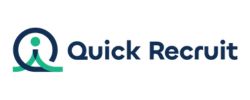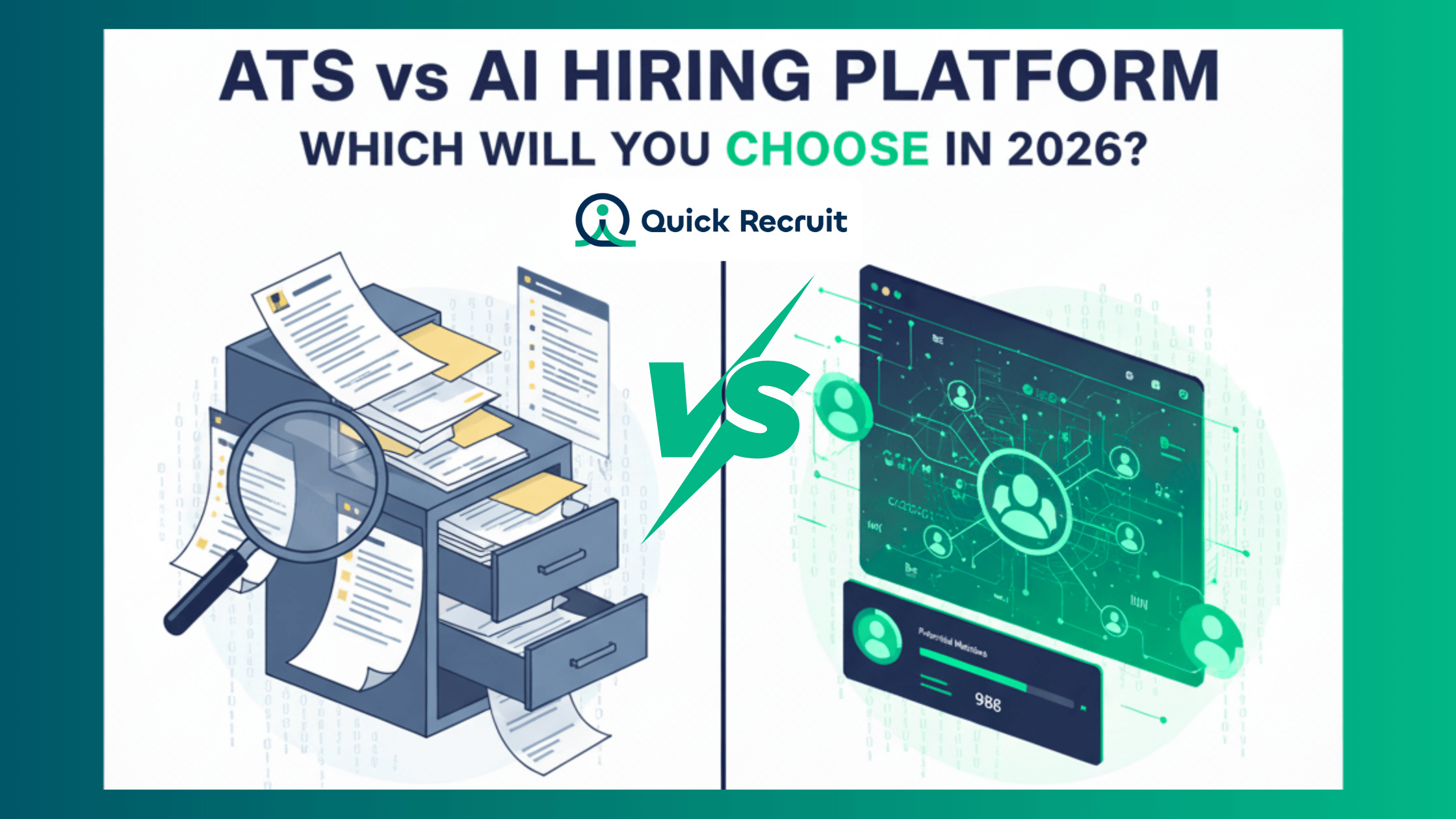Table of Contents
- ATS vs AI Hiring Platform at a Glance
- What is an Applicant Tracking System (ATS)?
- What is an AI Hiring Platform?
- Feature Face-Off: Real User Impacts
- Where the ATS Still Wins—and Where It Doesn’t
- Why Upgrade to AI?
- Is Your Company Ready to Switch?
- Smarter Together: Hybrid Approaches
- Case Study: QuickRecruit in Action
- What’s Ahead: The Future of Hiring Tech
- Making Your Decision
“The secret of my success is that we have gone to exceptional lengths to hire the best people in the world.” -Steve jobs”
Recruiting amazing talent is the lifeblood of every growing business—but finding the right people is more complex than ever. In fact, Deloitte’s Human Capital Trends report found that over 70% of executives believe AI will significantly transform recruitment in the next three years. The playing field has changed: classic Applicant Tracking Systems (ATS) are no longer the only option. Enter the powerful world of AI hiring platforms—smart solutions using artificial intelligence to take hiring to the next level.
Navigating these options can feel overwhelming. This guide breaks down the real differences between ATS and AI hiring platforms, digs into how each works in the 2026 market, and offers a clear playbook for making the best choice for your team.
ATS vs AI Hiring Platform at a Glance
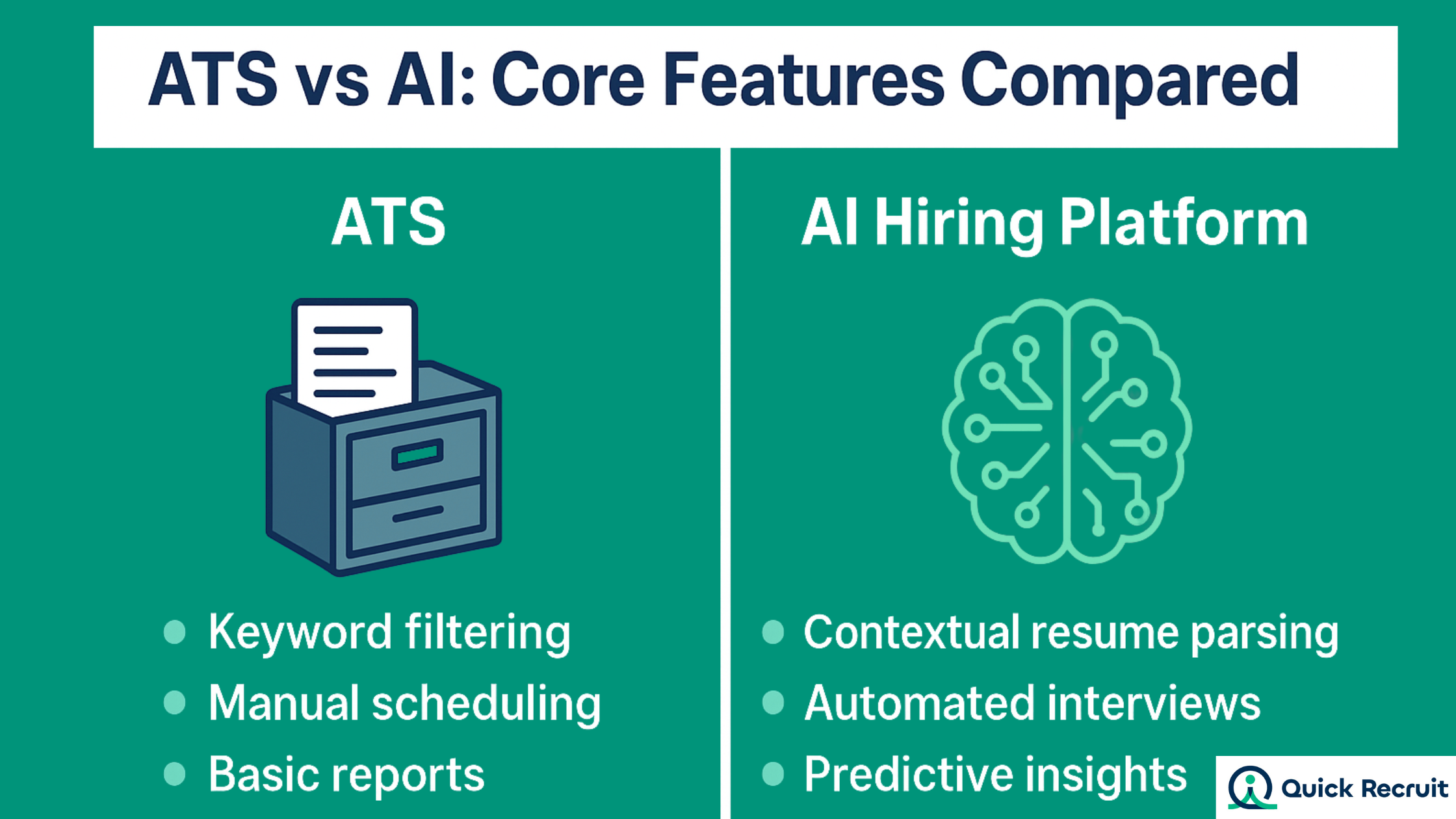 Your tech stack defines your hiring game. Here’s a one-minute comparison:
Your tech stack defines your hiring game. Here’s a one-minute comparison:Feature | ATS: Applicant Tracking System | AI Hiring Platform |
Screening | Relies on keywords | Contextual—reads skills, sees potential |
Sourcing | Waits for applicants | Finds and suggests top matches |
Interviewing | Manual scheduling | Automated, AI-enhanced screening |
Engagement | Batch emails, slow responses | Personalized chatbots, instant updates |
Analytics | Basic, historic data | Predictive, actionable insights |
Automation | Some admin workflows | Repetitive tasks handled end-to-end |
Core Value | Organizes hiring, ensures compliance | Drives efficiency, better hires, growth |
What is an Applicant Tracking System?
Think of an ATS as recruitment’s version of a digital filing cabinet. Developed in the ’90s, it collects applications, keeps them organized, and tracks each candidate as they move through your hiring stages. It’s reliable, familiar, and gets the basic administration out of your way.
What an ATS does:
- Posts your jobs out to boards and your careers page
- Stores stacks of resumes in one place
- Uses keyword filters to screen candidates
- Moves applicants through custom hiring pipelines
- Delivers basic compliance and reporting features
For straightforward hiring needs or small teams, an ATS can still do the trick. But is it keeping up with today’s competitive, candidate-driven landscape? That’s the big question.
What is an AI Hiring Platform?
An AI hiring platform is built for speed, intelligence, and better decision-making. It uses artificial intelligence—think machine learning, natural language processing (NLP), and predictive analytics—to identify the best-fit candidates, automate routine tasks, and give you an edge your competitors wish they had.
This shift represents the rise of artificial intelligence recruiting — a smarter approach that blends automation with context-driven insights.
How an AI platform ups your game:
- Understands Resumes in Context: Goes far beyond keywords, grasping real skills and experience.
- Predicts Best Matches: Surfaces hidden talent from your database (and external pools) before you even search.
- Automates Screening: Uses algorithms to score applicants and flag the top tier.
- Conducts AI-Assisted Interviews: Schedules, runs, and assesses interviews with speed and accuracy.
- Creates Real-Time Engagement: AI chatbots keep candidates informed and involved, 24/7.
- Drives Insights: Predicts hiring success, flags issues, and constantly improves your process.
You get what every recruiter dreams of: less time copying data, more time closing amazing hires.
Feature Face-Off: Real User Impacts
Let’s get specific. How do these platforms compare in the day-to-day life of hiring teams and candidates?
1. Resume Screening
- ATS: Automatically bins resumes if they don’t contain exact keywords—qualified candidates are easily overlooked.
- AI Platform: Reads context, identifies relevant experience, and connects similar roles/skills across industries.
Impact: Applicants finally have a fair shot. Recruiters spend less time sifting through “resume black holes.”
2. Sourcing Candidates
- ATS: Mostly passive (open jobs, wait for applications).
- AI Platform: Proactively finds and ranks talent—re-activates prior applicants, searches external databanks, and predicts fit.
Impact: Hiring pipelines are always full. No more panicked sprints to find extra candidates.
3. Interviewing
- ATS: Manual reminders, emails, and lots of calendar tag.
- AI Platform: Automated invites, reminders, on-demand video or skill-based tests analyzed by AI.
Impact: Interviews are set up in minutes, not days. Recruiters spend more time evaluating, less time chasing confirmations.
4. Candidate Engagement
- ATS: Templated emails, sometimes delayed responses, candidates left guessing.
- AI Platform: Real-time chatbots answer questions and keep everyone up to speed.
Impact: Candidates feel valued. Brands get a reputation for responsiveness.
5. Analytics & Reporting
- ATS: Historical stats—applicant numbers, sources of hire, and time-to-fill.
- AI Platform: Predicts which candidates will succeed, flags bottlenecks, and helps you course-correct instantly.
Impact: Hiring finally runs on data—not gut feel.
Strengths and Weaknesses of Each Approach
No single tool is perfect for every organization. Understanding the trade-offs is key to making the right choice.
When an ATS Still Makes Sense
- Simplicity and Familiarity: For small teams with low hiring volume, the straightforward nature of an ATS can be sufficient.
- Budget-Friendliness: The upfront cost of a basic ATS is typically lower than a full-featured AI platform.
- Compliance: ATS platforms are well-established and have robust features for meeting basic reporting requirements.
Where an ATS Falls Short
- Keyword Dependency: It often screens out qualified candidates who don’t use the “right” keywords.
- Poor Candidate Experience: Generic communication and a lack of transparency lead to frustration.
- Manual Workload: Recruiters spend too much time on administrative tasks instead of strategic activities.
- Lack of Insight: Basic reporting doesn’t help improve hiring strategy or outcomes.
Even a modern ATS struggles to match the adaptability and contextual decision-making of AI-driven platforms.
Strengths of AI Hiring Platforms
- Speed and Efficiency: Automates up to 80% of repetitive recruiting tasks.
- Improved Quality-of-Hire: Focuses on skills and potential, leading to better long-term hires.
- Enhanced Candidate Experience: Delivers personalized, real-time communication.
- Fairer Hiring: Reduces unconscious bias in the screening and assessment process.
Challenges with AI Platforms
- Initial Cost: The investment can be higher, though the ROI is often realized through efficiency gains and better hires.
- Integration Complexity: Integrating a new platform with existing HR systems like your HRIS requires careful planning.
- Change Management: Teams may be skeptical or require training to trust and adopt AI-driven recommendations.
Which Is Right for You? A Decision Framework
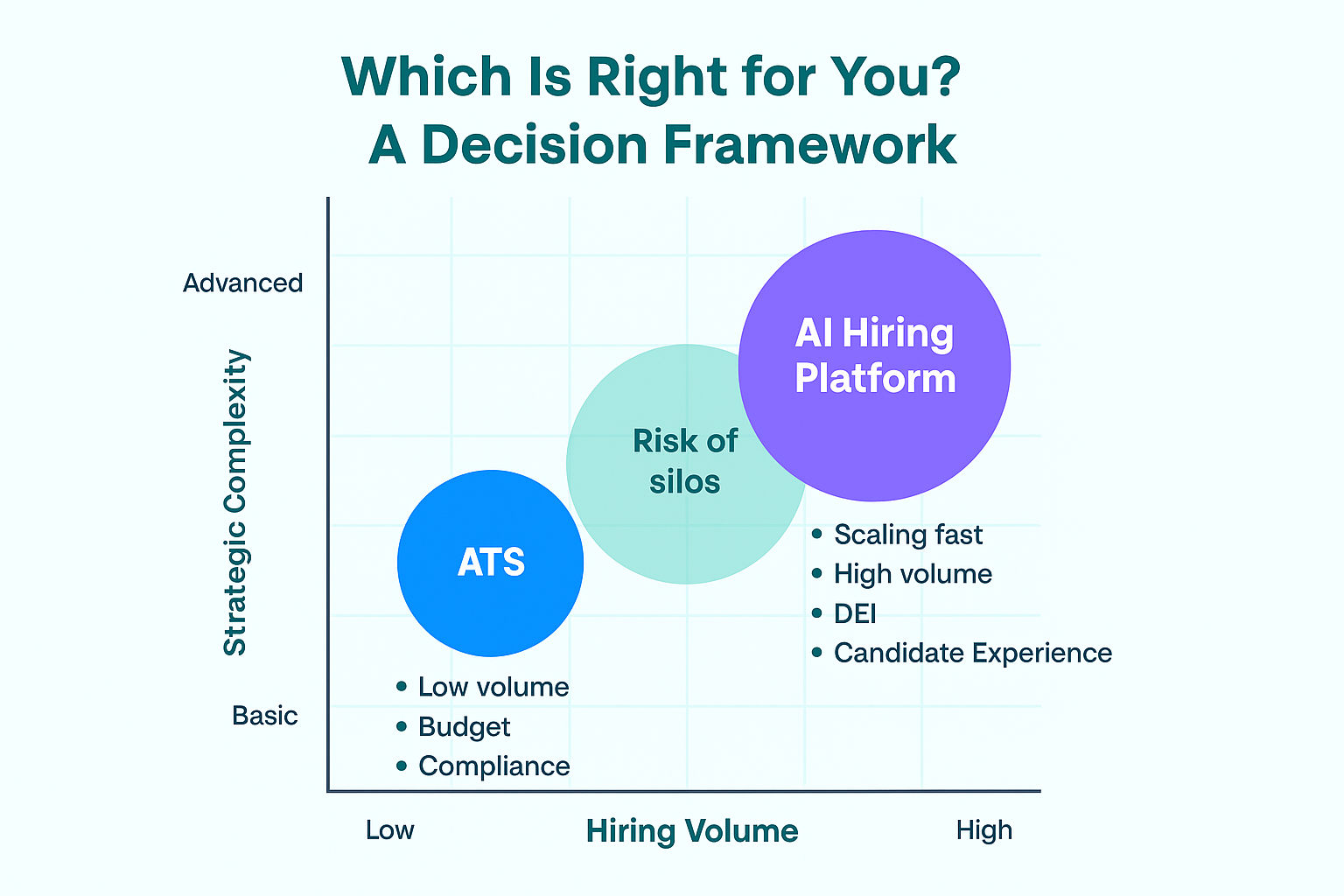
Your choice depends on your company’s size, hiring velocity, and strategic goals.
When to Stick with Your ATS
If you are an early-stage company hiring only a few roles per year, a traditional ATS may be all you need. Your focus is likely on basic organization and compliance, and the volume doesn’t justify the investment in advanced automation.
When to Choose an AI Hiring Platform
You should strongly consider an AI hiring platform if your organization is:
- Scaling rapidly and needs to hire for dozens or hundreds of roles.
- Struggling with high hiring volume and recruiter burnout.
- Focused on improving quality-of-hire and reducing turnover.
- Committed to enhancing DEI and reducing bias in your processes.
- Seeking a competitive advantage through a superior candidate experience.
The Hybrid Approach: A Potential Pitfall
Some organizations try to get the best of both worlds by integrating specialized AI tools with their existing ATS. However, this often leads to a fragmented tech stack, a disjointed user experience, and data silos. A more effective solution is a unified AI hiring platform that includes robust ATS functionality. This provides a single source of truth and a seamless workflow from sourcing to hire.
Spotlight: Platforms Designed for the Future
Modern platforms are emerging that combine the compliance strengths of a next-generation ATS with the intelligence of powerful AI recruitment software. These systems address the core pain points of traditional hiring by providing a single, unified solution for the entire talent lifecycle.
Unlike traditional ATS tools, modern AI recruitment software goes beyond storage and tracking — it delivers intelligence, automation, and predictive insights recruiters can act on immediately.
With a platform like QuickRecruit, you can:
- Automate sourcing and screening with AI that understands context, not just keywords.
- Engage every candidate with a personalized, chatbot-driven experience.
- Reduce bias and improve DEI with fair and objective evaluation tools.
- Gain predictive insights to continuously optimize your hiring strategy.
These platforms are designed for fast setup and a low learning curve, ensuring your team can realize value quickly without a massive implementation project.
The Future of Hiring: What to Expect by 2030
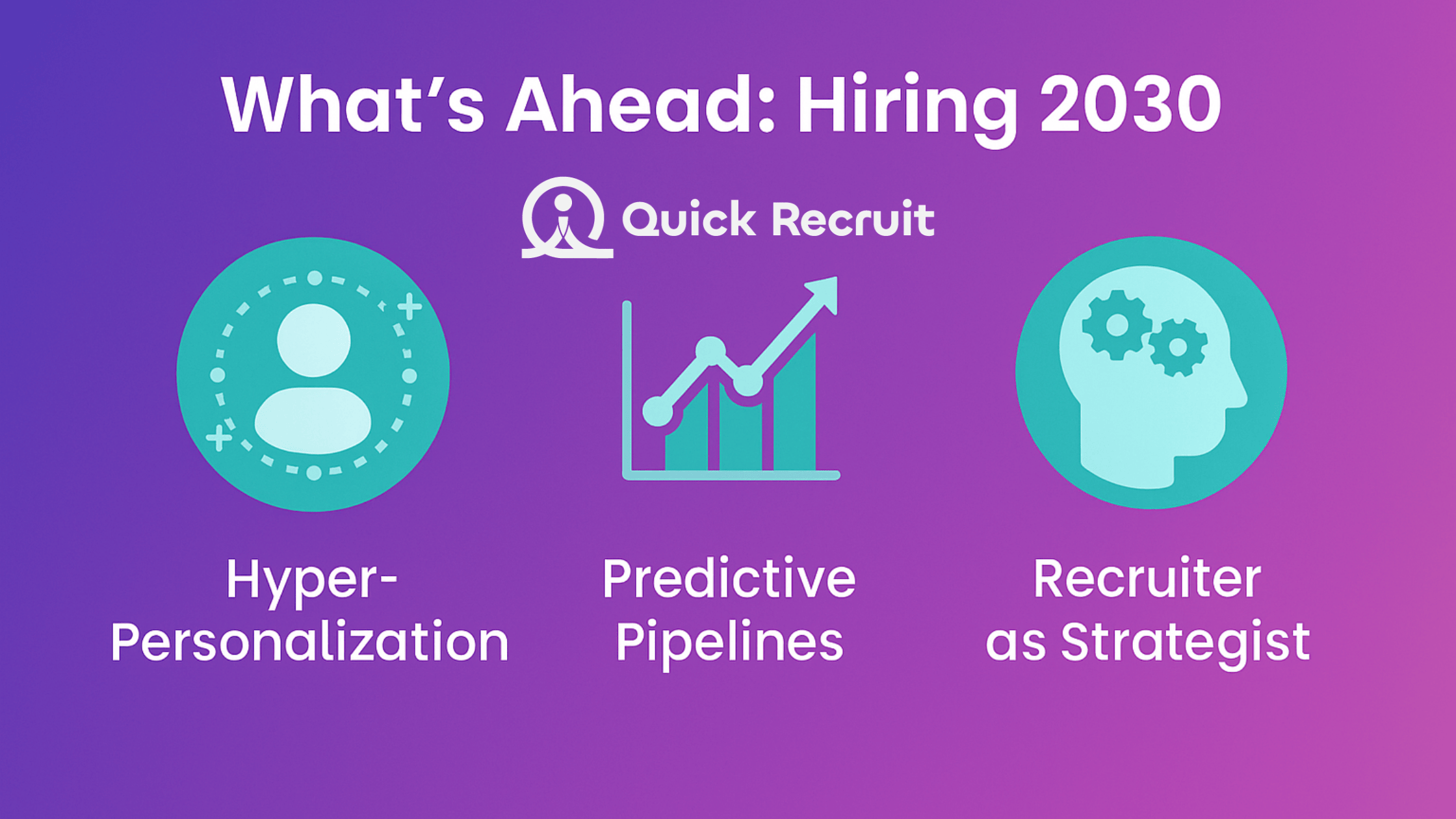
Exploring the future of AI in recruitment helps talent leaders prepare for a world where hiring becomes predictive, personalized, and skills-first.
The evolution from ATS to AI platforms is just the beginning. The role of AI in recruitment is set to grow even faster by 2030, reshaping how companies attract, engage, and evaluate candidates.
By 2030, we can expect:
- Hyper-Personalization: AI will create unique hiring journeys for every candidate based on their skills and career aspirations.
- Predictive Talent Pipelines: Platforms will forecast future hiring needs and proactively nurture talent pools before roles even open.
- The Recruiter as a Strategist: With administrative tasks fully automated, recruiters will focus on building relationships, advising hiring managers, and shaping talent strategy. The era of keyword-based hiring will be over, replaced by a holistic, skills-based approach.
Making Your Decision
When it comes to ATS vs AI hiring platforms, think about where your business is headed—not just where it is right now.
- Stick with ATS if your hiring volume is low, budget is a priority, and compliance is the main concern.
- Switch to AI if you want to hire faster, smarter, and more fairly, and you’re aiming to build a best-in-class team.
For most companies with growth ambitions, an AI hiring platform is the smarter move—creating real business impact through better hires and happier teams.
Final Word: Scale Smarter in 2026
Don’t let your hiring process hold your team back. The right tech helps you spend less time on admin and more time connecting with the right talent to drive your company forward. Choose progress—ditch the “old way” and give your recruiters the tools they need to shine.
To stay competitive, companies need smart recruiting technology that reduces admin work and helps them focus on building high-performing teams.
Ready to experience the next level of hiring?
Book a demo with QuickRecruit and discover how easy, powerful, and candidate-friendly your hiring process can be.
